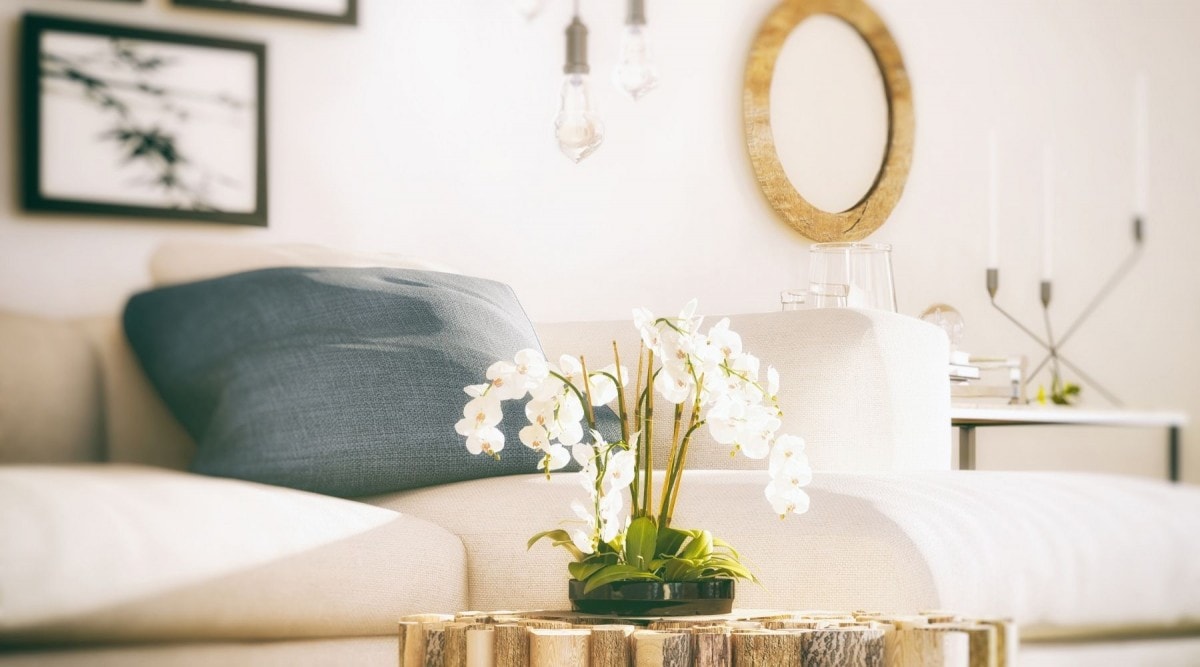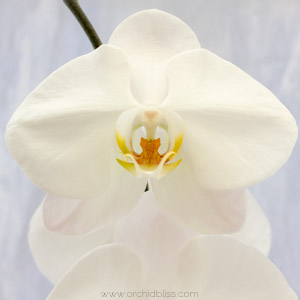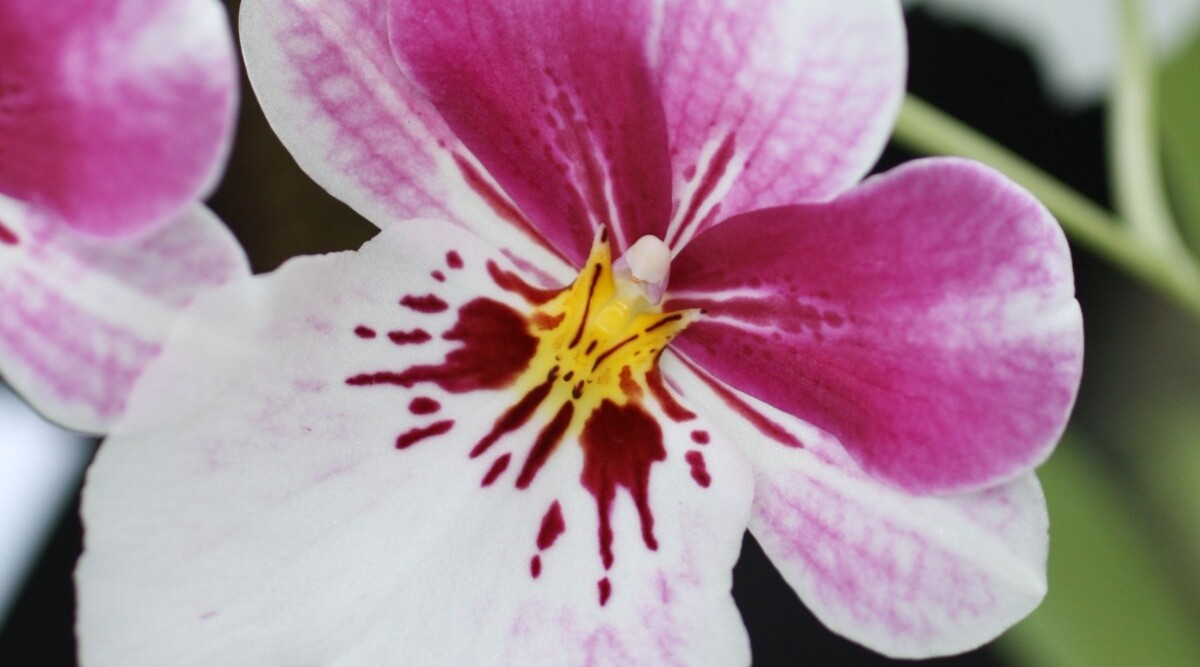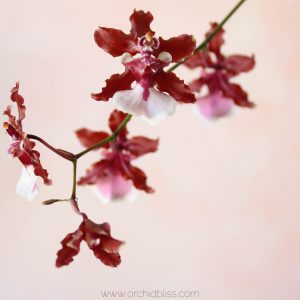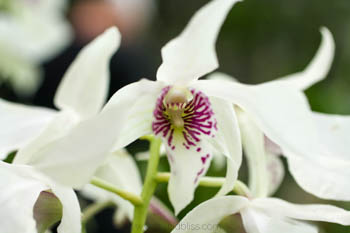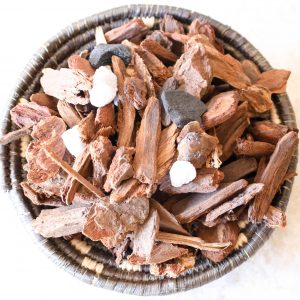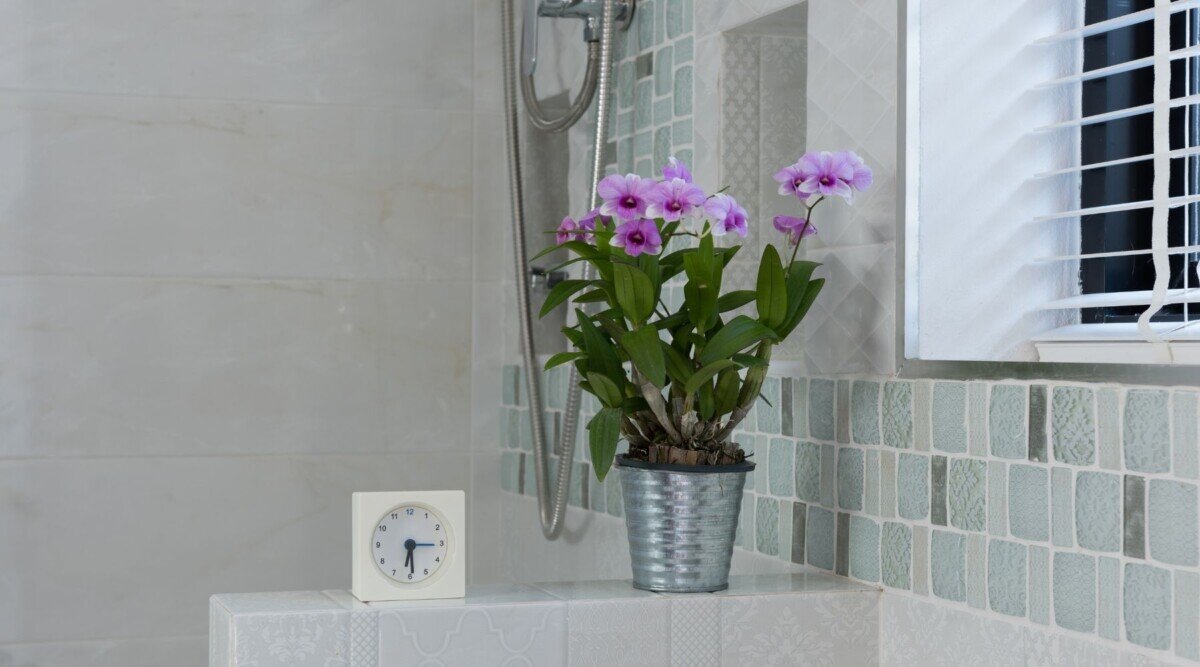
8 Best Orchids for Bathrooms
If you live in the right climate, orchids thrive outdoors, but, if you don’t, no worries. Here are some orchids that are great to keep inside the house. These orchids will brighten up your console table or make a beautiful centerpiece, especially when in bloom. More and more people are also placing orchids in their bathrooms, which may seem an unlikely spot but are actually a good place for some orchid varieties.
The best orchids for bathrooms are those that prefer high humidity because they love the room’s damp and steamy environment. Low-light orchids make great choices, too. These orchids include certain species of Phalaenopsis, Miltonia, Paphiopedilum, Oncidium, Dendrobium, Masdevallia, Bulbophyllum, and Encyclia.
This article will take a look at the growing conditions that specific orchids require and how bathrooms could be an ideal place for them. So read on to know which orchids to get for your bathroom and what you need to do to make this part of your house a more suitable spot for these plants.
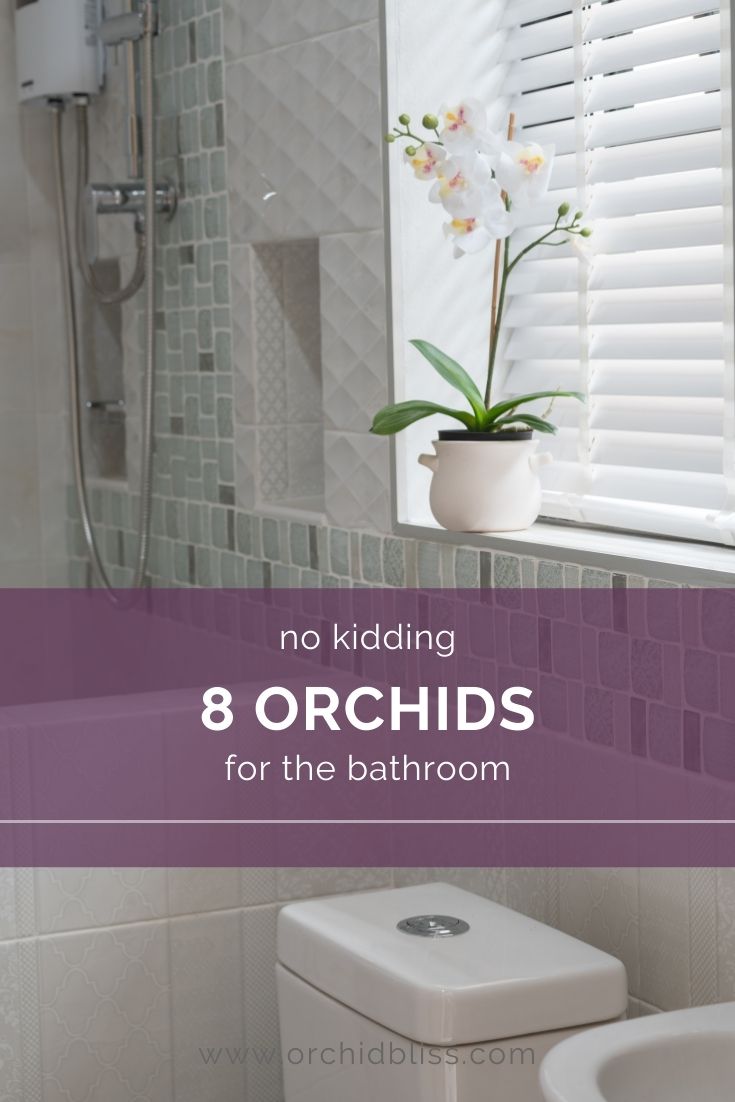
Some of the links on this page may be affiliate links. Click here to learn more.
Keeping Orchids Indoors
Most species of orchids prefer a high-humidity environment. Depending on what type of orchid it is, relative humidity of 40 to 80 percent is ideal. However, living rooms generally have only about 30 percent relative humidity and offices with central heating or air conditioning units running the entire day have around 27 percent.
This means that the usual indoor spaces where we typically display our plants tend to be too dry and are not humid enough for orchids.
Why Bathrooms Are a Great Spot for Orchids
Bathrooms are a good place for certain varieties of orchids and some other tropical plants because they provide the perfect growing environment. For one, bathrooms are typically warm and damp, and the water you need to irrigate your plants is close by.
Many bathrooms are also darker than other indoor spaces or rooms at home because they have smaller and fewer windows. Most bathrooms only have a single window, and some have none at all. So orchids that prefer low light conditions or at least indirect sunlight would do well in the toilet or bath with a window providing bright light.
Bathrooms Are Great but Not Perfect
While bathrooms are considerably more humid than the rest of the house because it is where you take showers and condensation drips down its tiled walls afterward, you need to remember that its humidity levels and temperature do fluctuate. This condensation dries.
This means that even though there is a lot of warm and humid air in the room when you shower, this can only last for a short while. After several minutes, everything goes back to being naturally dry until somebody else comes in and takes another bath or shower.
The bathroom also gets significantly colder when it has been left unoccupied or unused for hours. Thanks to all the ceramic tiles, glass, and metal fixtures. So you can imagine how cold it gets at night when nobody takes showers and baths anymore. Needless to say, these wide fluctuations in temperature and humidity levels may not be suitable for every orchid.
So if you are placing orchids in the bathroom, these are things you definitely should consider. One good solution is to have a humidifier ready. You can also place your orchid on top of a tray with stones. This way, your humidity is more constant.
Another issue with bathrooms is ventilation or air circulation. Your orchid will need free, unobstructed airflow. Because, yes, orchids breathe, and they do it through small pores or stomata under their leaves. The stomata allow proper gas exchange between oxygen and carbon dioxide.
Good air circulation will prevent mold and rot from setting in your orchid. It will also release toxic gases from the bathroom. By toxic gases, we mean those that come from the beauty and body care products you use, like nail polish, hair spray, and hair dye as well as toilet cleaning products and chemicals. But while most bathrooms have exhaust fans, they do not run all the time. This is why it would be good to open your bathroom window as frequently as possible. I’ve found that a small fan, set to low and pointed away from the orchid works well.
Improper watering often causes a host of problems, resulting in an unhealthy orchid. To avoid these pitfalls, click here to grab your cheat sheet to learn how to grow healthier orchids. It will be super helpful.
Phalaenopsis or Moth Orchid
Phalaenopsis grows in the shade in their native habitat, and this makes it one of the best easy-to-care low-light orchids you can place in your bathroom. They are great for beginners, not to mention accessible since they are commonly sold at supermarkets and even convenience stores.
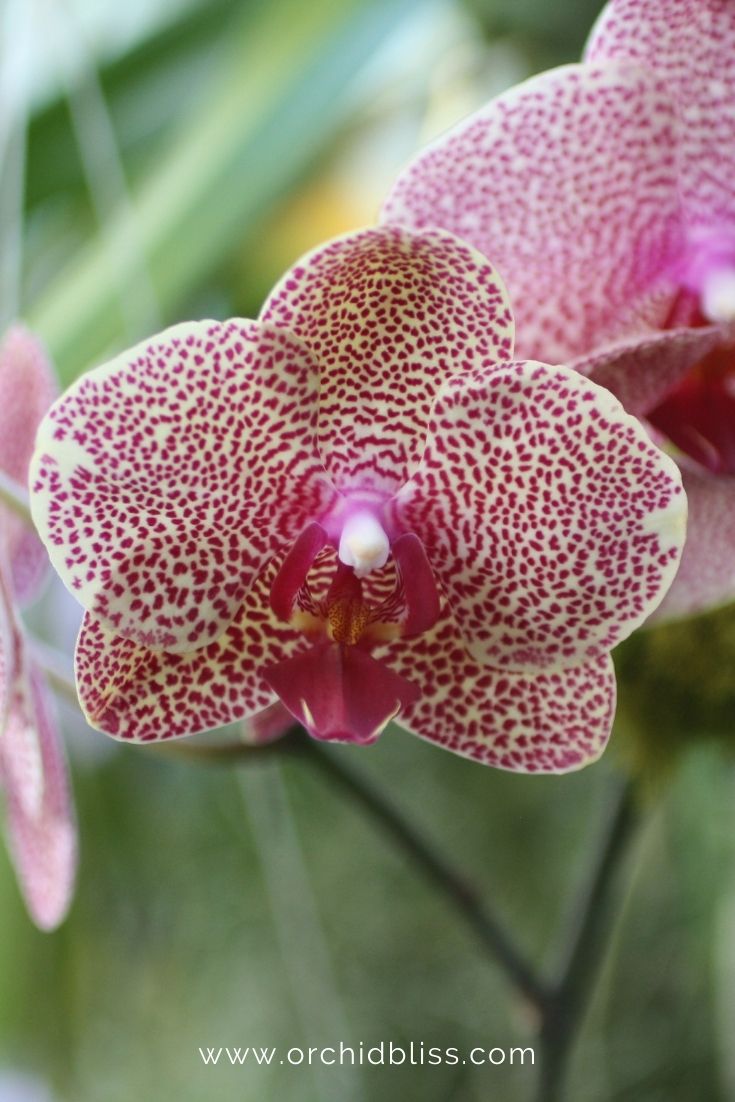
A moth orchid can easily be grown indoors, and it stays in bloom for a long period. In fact, a mature moth orchid is going to produce flowers throughout the year. This orchid makes a good houseplant and will do well with windowsill light or moderately bright and indirect light as well as with consistent moisture.
With these bare minimums, it will grow and flower. A moth orchid will produce only one new leaf or two each year. This is called the growth cycle, and when this is complete, a spike with blooms will come out from its stem. This usually occurs in the fall, when temperatures start to drop, and it begins to go on its dormant phase.
However, if your orchid is grown inside the house, where it is consistently warm, it may not realize that the seasons have changed. So you may want to simulate autumn indoors. You can do this by lowering the temperature for several nights, just enough to trigger a bloom spike.
If your bathroom gets a lot colder during nighttime, then you may only have found the perfect spot for your moth orchid during the start of its dormancy. Typically, moth orchids bloom from late winter through spring.
To help you further, start by downloading my free cheat sheet to see where to cut the orchid flower spike after blooms have faded to trigger re-blooming. Click here, for the cheat sheet. It’ll be super helpful.
Miltonia or Pansy Orchid
This orchid is a show-stopper because of its bold patterns and bright colors, and it has been described as a very friendly-looking orchid, with its open blooms looking like faces and resembling pansies. This orchid originated in Brazil’s cloud forests, so, in cultivation, it thrives in temperatures that are not too hot during the day and in highly moist environments.
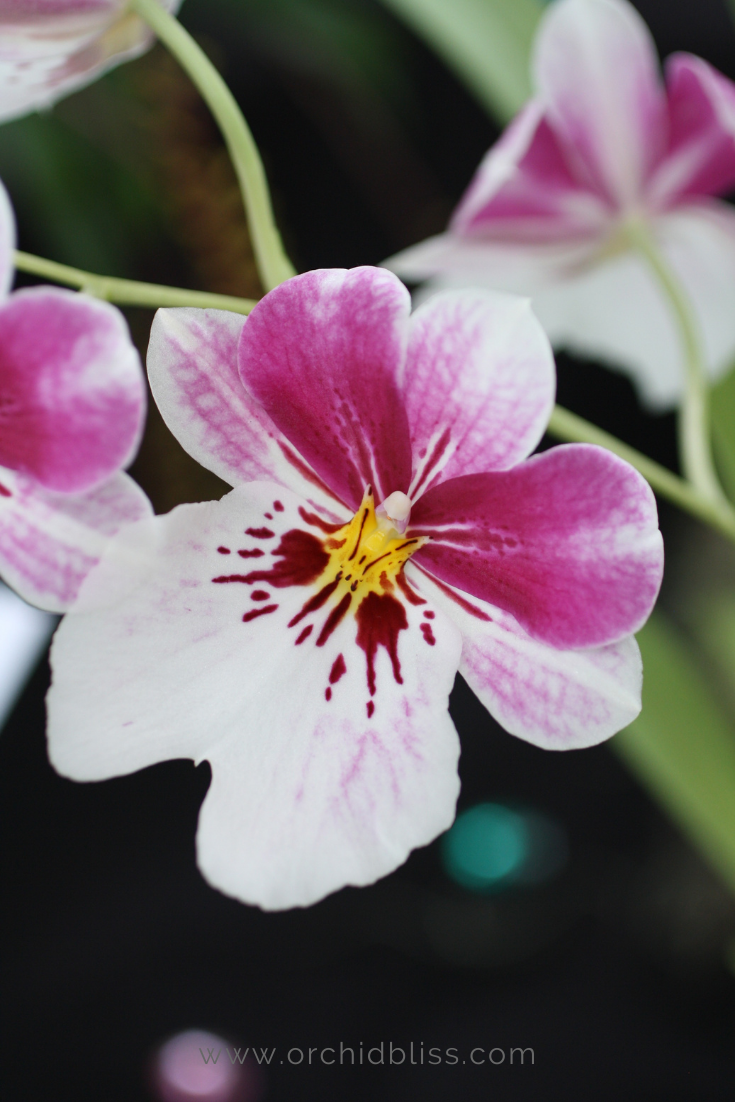
There are two categories of Miltonia or Pansy Orchids: the cool-growing Miltonia, actually called Miltoniopsis, and the warm-growing Miltonia. Keep in mind that it is not uncommon for both these orchids to be labeled Miltonia.
Here’s how to tell the difference. Miltonia flowers are more pointed and Miltoniopis are more rounded – more of the familiar pansy shape.
The easier of the two orchids is the intermediate to warm-growing Miltonia. This orchid is quite adaptable but does best mounted as it will quickly outgrow a pot.
Miltonia orchids love bright, indirect, diffused light when placed indoors. They are very sensitive to hot sunlight and, if left under it for a long time, their leaves will get burn marks. These orchids do well under lights. So, if your bathroom doesn’t get enough light on its own, adding a grow light is always an option. They would also do well in a room where the temperature doesn’t drop below 59°F (15°C) at night.
These orchids love daily misting. Water them once a week, and don’t let them get too dry or too wet. As always, when misting, mist the roots, not the leaves. Misting the leaves can lead to bacterial or fungal spotting.
Miltoniopsis prefer cooler temperatures, less light, a finer potting mix, and a more damp potting mix than the Miltonia. They are also easier to contain in a pot than the Miltonia, though both varieties should be re-potted yearly and fertilized weekly.
Paphiopedilum or Lady Slippers
Paphiopedilum orchids are also some of the easiest orchids to care for, and they make good indoor plants. These orchids produce long-lasting blooms. They are named slipper orchids because of the flower’s pouch-like petal, shaped like a slipper to attract pollinators. Most of these species of orchids are semi-terrestrial, which means that they grow in a finer potting mix than most orchids – though still not a traditional potting mix.
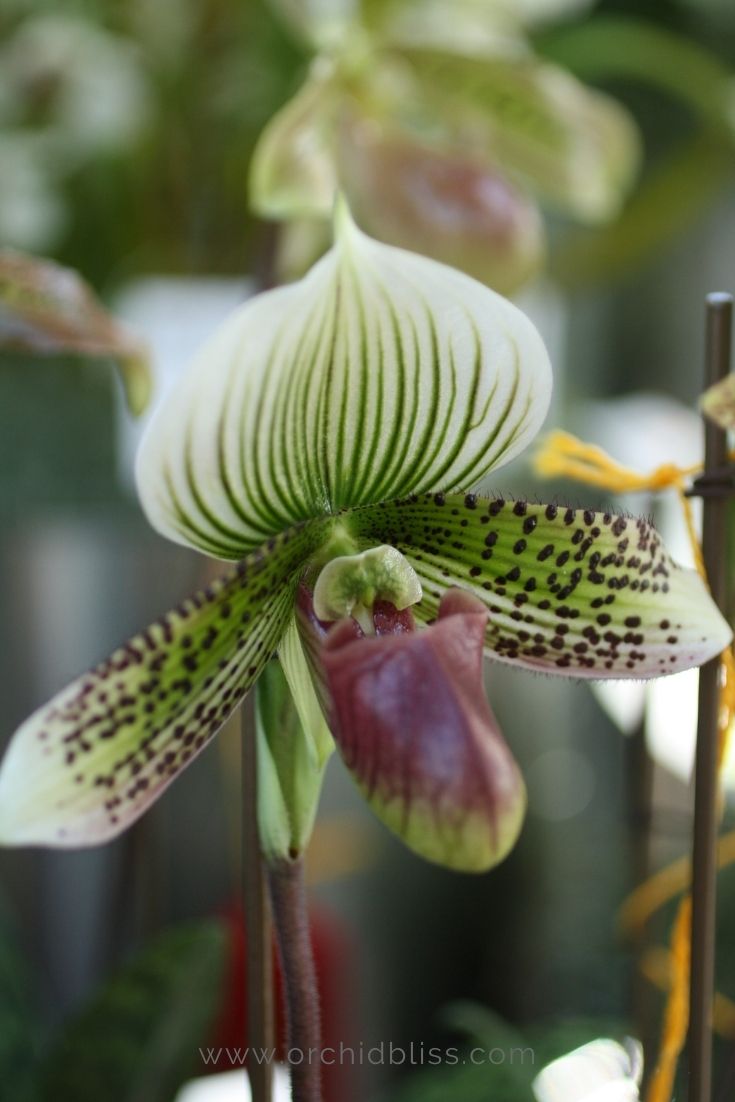
In their native habitat, Paphiopedilums grow on the forest floor and near wetlands and swamps. That means they don’t receive direct sunlight. As such, in cultivation, these orchids do well under low light conditions. Just to be clear, slipper orchids still need light. If you have enough light to grow a Phalaenopsis orchid, you have enough light to grow a Paphiopedilum orchid.
You can place your orchids near a window or under fluorescent lighting, but keep them away from direct sunlight and do not expose them to over 85°F (30°C) for a long period of time. Too much heat or strong sunlight could cause sunburned leaves. They also love humid air.
Water your Paphiopedilums once a week or when the soil is dry. Do the fingertip or toothpick test to make sure that the top layers of the potting medium have dried out completely and that the roots have drained fully. The trick to watering slipper orchids is to keep the potting media just barely damp.
This orchid will bloom yearly, in late winter. When searching for this type of orchid, you may want to look for these varieties:
- Paphiopedilum hirsutissimum
- Paphiopedilum Yi-Ying Twinkling Stars
- Paphiopedilum vejvarutianum
Oncidium or Dancing Ladies
Oncidium orchids, also known as dancing ladies or dancing doll orchids because of their distinctive floral design, boast a spike with blooms that resemble fluttering butterflies. Oncidium orchids originated in the rainforests and, as such, prefer cooler temperatures at nighttime.
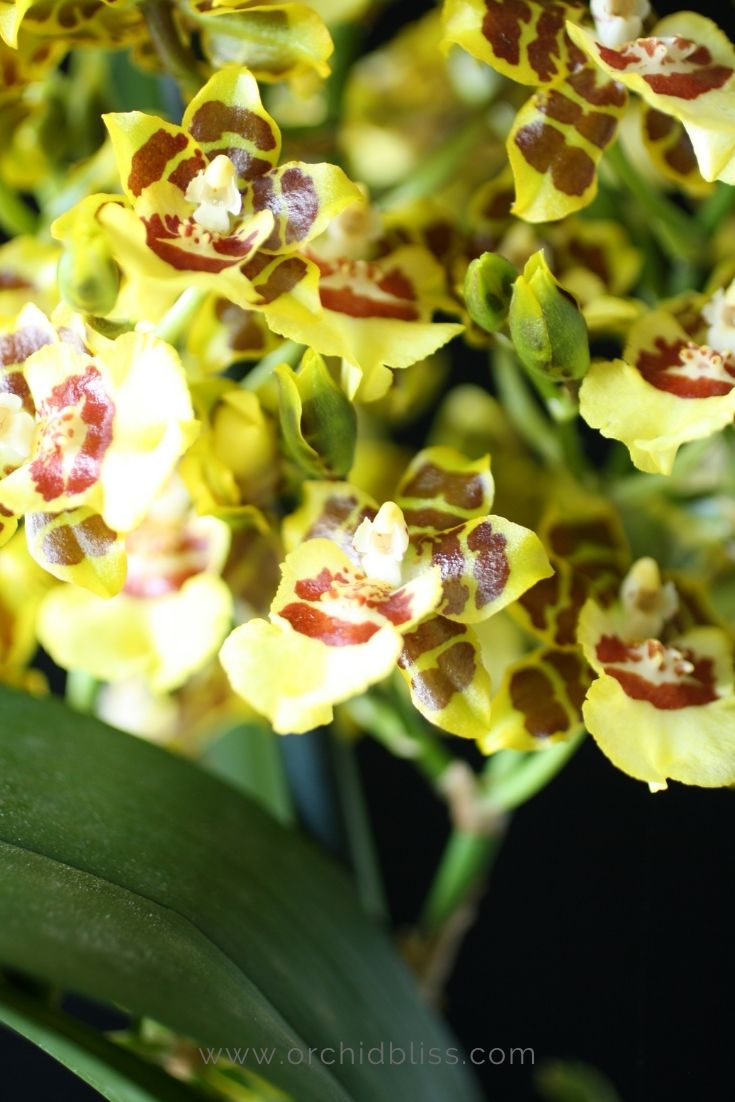
Oncidiums are light-loving orchids, so if you want to place one in your bathroom, you need to have windows there that allow light to come in and provide a bright spot for your plant. However, if the sun is too bright, you may want to filter it with a translucent shade or even a sheer curtain.
These orchids need a few hours of sunlight every day. You can feel their leaves to know if it needs more light or less. Oncidiums that need more sunlight tend to have thick, fleshy leaves, while those with thinner leaves can do better with less.
You should note that these orchids are a bit particular in terms of temperature. They like the room warm during the day, with average temperatures of 80 to 85°F (27 to 29°C). A heat spike of up to 100°F (38°C) will not hurt them, as long as they get to cool off after. However, these orchids like the air to be cooler, around 60 to 65°F (18°C), at night.
Most bathrooms are warm during the day and get cooler at night, so it wouldn’t be a problem if it can get to these temperatures. If that’s not the case, you may want to place your plant somewhere where you can manipulate the temperature.
Oncidium flowers typically come in shades of white, pink, red, or yellow. When looking for this kind of orchid to keep as a houseplant, you may want to look for Oncidium ‘Sharry Baby,’ or Oncidium ‘Volcano Queen,’ Oncidium ‘Twinkle.’ To learn more about Oncidium orchids, CLICK HERE.
Dendrobium
Dendrobiums are some of the most common and popular orchids among home growers. Dendrobium is a large genus of orchids with over a thousand species, so you would surely find many varieties that would perfectly fit your home environment and whose growing conditions you could easily provide.
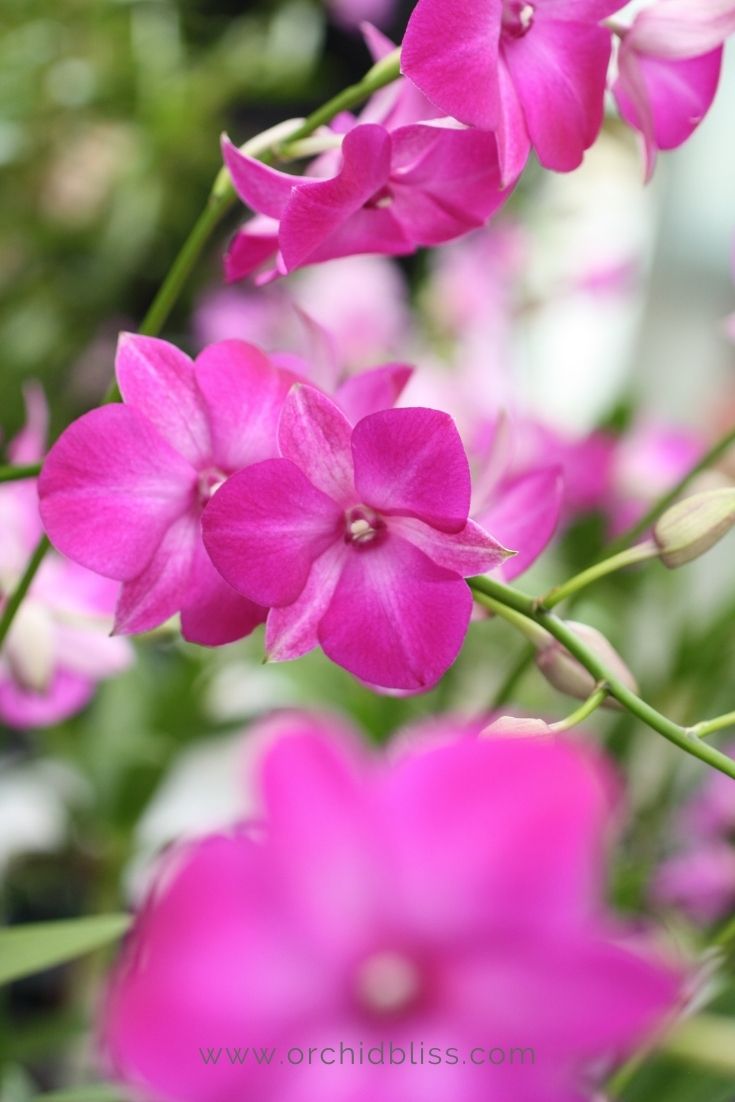
When growing Dendrobium orchids, you need to know three important rules.
- First, these orchids like to be in small pots and have their roots crowded in. These roots are likely to retain moisture and start rotting if you try to move the plant in a big pot to give them more space to spread out.
- Second, Dendrobium orchids need as much bright light as they can get. But this doesn’t mean that you should stick them in direct sunlight.
- Third, there are many varieties of Dendrobiums so stick with the easy-to-grow varieties such as Dendrobium kingianum, Den. nobile hybrids, Den. phalaenopsis hybrids. Check out this Dendrobium care card for more specific information.
Usually, a south-facing window will do or, in this case, a bright and well-lit bathroom. You would know that your Dendrobium is not getting enough sunlight if it is not flowering.
Masdevallia
Masdevallia orchids are considered great “windowsill” orchids. Orchids placed on windowsills perform best when they are on an east-facing or west-facing window, where they can receive some light in the morning and the afternoon, without exposure to direct sunlight.
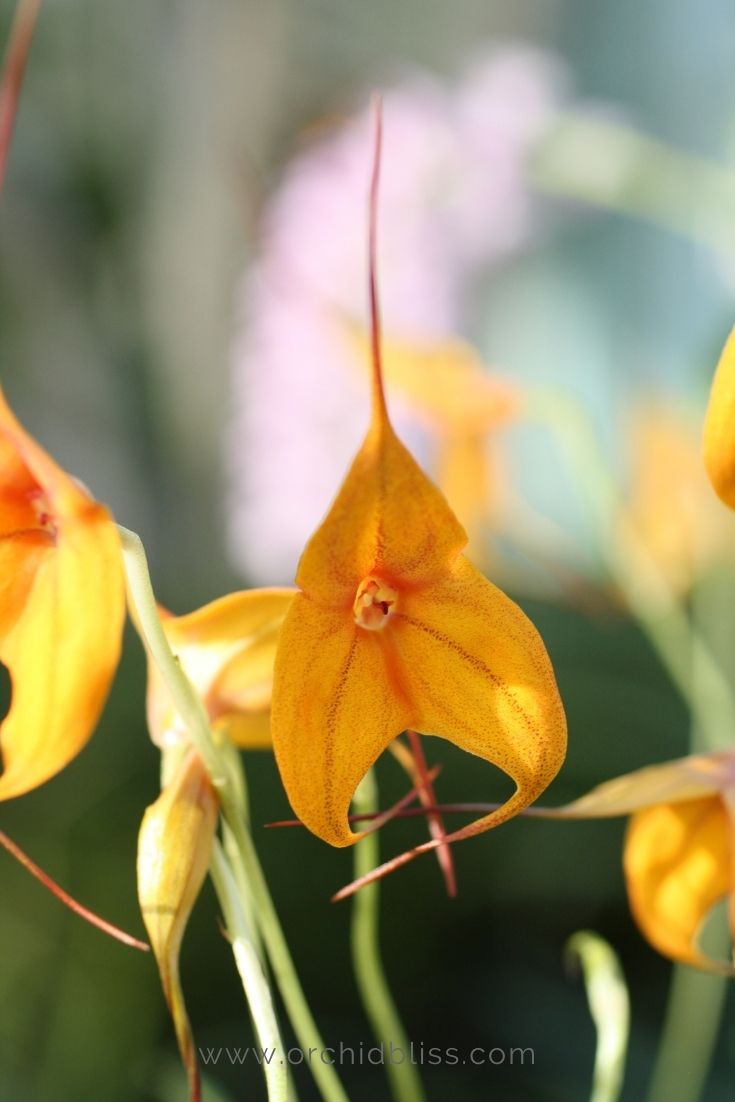
For Masdevallia orchids to thrive indoors, give them low or medium-light intensity. Give them too much light, and their leaves will turn yellow. Give them too little light, and their leaves become dark green and elongated. Now, if you have a brightly lit windowsill in your bathroom, make sure to put the plant in a spot away from the light.
Masdevallias are summer-blooming orchids that produce flowers with an atypical shape: triangular, some being blocky and compact, while others are elongated, thin, and whisker-like. These orchids are rather particular about humidity conditions and temperature, so they are best suited for more experienced orchid growers. The genus has nearly 500 species, but only a few are grown as houseplants.
More specifically, the orchid requires cool to intermediate temperature. Its ideal temperature during the day is between 65° to 75°F (18.3° to 23.9°C), while the temperature at night should be between 55° and 60°F (12.8° to 15.6°C). A 10-degree to 15-degree difference between daytime and nighttime temperature is ideal. As for humidity, a Masdevallia orchid needs high humidity.
If you are looking for a Masdevallia orchid for your bathroom, consider getting these introductory species: Masdevallia floribunda, M. infracta, M. nidifica.
Bulbophyllum
Bulbophyllum is a unique and weird orchid, and most home growers have a love-hate relationship with them. However, Bulbos are easy to grow and care for.
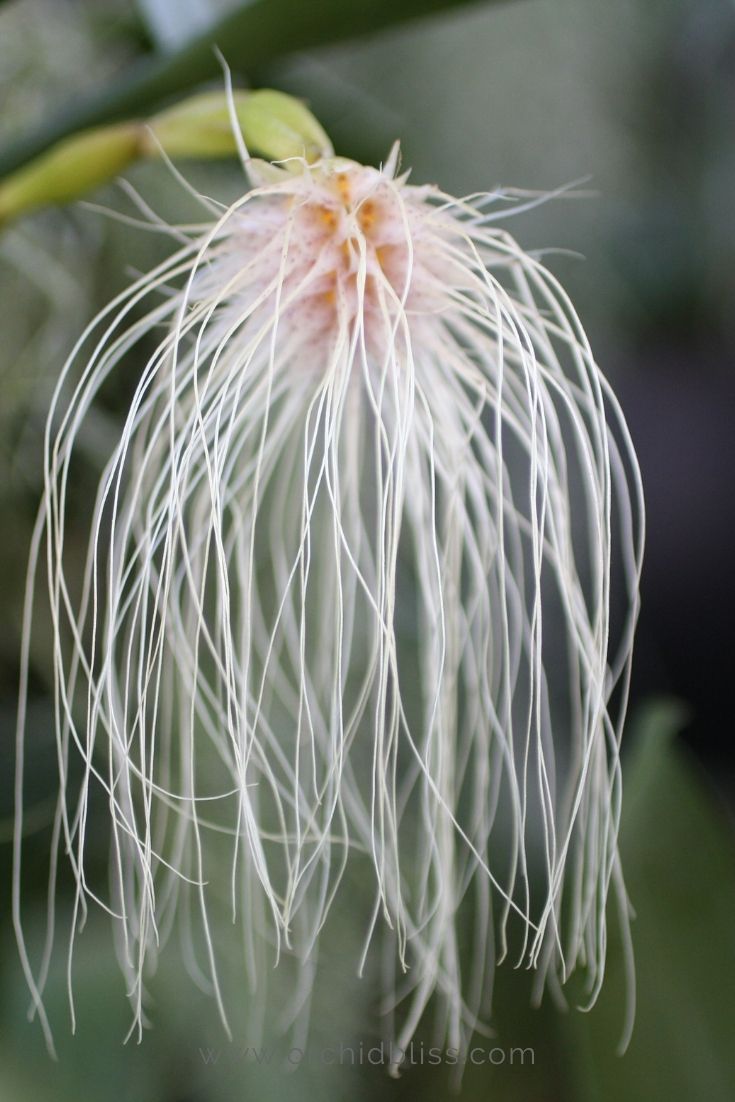
Bulbophyllum orchids have a wide range of native habitat conditions, from the constantly wet cloud forests of various mountain altitudes to seasonal habitats with periods of drought and monsoon. So there are Bulbos that are hot-growing species, and there are cool-growing species. For those that you want to grow indoors, go for Bulbos that need intermediate to warm range temperatures.
If you are looking for Bulbos, try getting a Bulbophyllum catenulatum orchid, which is a miniature orchid perfect for a vivarium or terrarium in your bathroom. You can also get the shade-loving Bulbophyllum facetum, which prefers low to medium light conditions.
Encyclia cochleata or Cockleshell, Octopus Orchid
The Encyclia cochleata orchid always inspires thoughts of the ocean. Whether it’s the dangling petals reminiscent of tentacles or the clam-shell-like lip. Images of sealife are readily evoked. Happily, this orchid is considered easier to grow and care for than most other species of orchids.
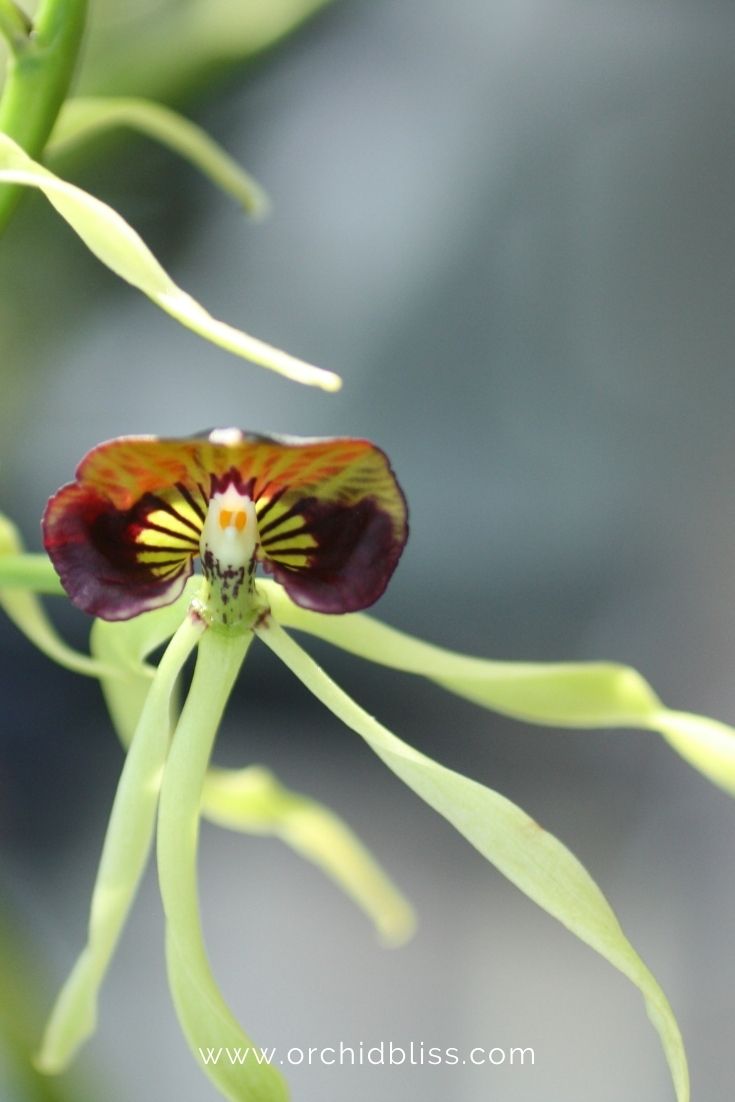
Encyclia cochleata orchids love filtered sunlight, so place it in a bright area with lots of indirect sunlight, like an east-facing window. You can also place your plant on a spot that is five feet away from a window that gets direct sunlight. Needless to say, this orchid needs to be protected from the hot afternoon sun. In addition, this orchid performs well under artificial lights.
The ideal temperature for this orchid is between 70°-80°F (21°-27°C) during the day with temperatures between 58°-65°F (14°-28°C) on winter nights. with humidity levels of at least 40 percent. If your room’s humidity is very low, you can put the orchid on a tray or plate filled with water and small pebbles. However, do not let the bottom of the pot touch the water.
The Encyclia cochleata orchid readily and continually blooms. It is compact, with large interesting flowers and a lovely fragrance.
Conclusion
When growing orchids indoors, keep in mind that every home and every bathroom are different. So, it’s important to know how suitable your bathroom is for orchids. See whether it will be able to give your orchid the growing conditions it requires, including lighting, temperature, and humidity.
You should also factor in that different species of indoor orchids need different levels of sunlight and humidity and have different ideal temperatures. Some want to be in a bright, well-lit room, while some are okay with low-light conditions. Some plants require high humidity, while some can survive with less. Though even so-called low-light orchids need light (at least 1000 fc) and low humidity orchids still need at least 40% humidity.
Related articles
24 Beautiful Dendrobium Orchids That Are Easy to Grow at Home
Hey, Windowsill Orchid Growers, This Is for You
ReadSources
- Orchideria: Is a Bathroom a Good Place to Keep an Orchid?
- Orchideria: 33 Best Low Light Orchids: Top Recommended Orchids for Shade
- The Spruce: 17 Best Houseplants for Your Bathroom
- The Spruce: 20 Types of Orchids to Use as Houseplants
- Gardenista: Best Indoor Plants: 6 Flowering Orchids to Grow
- Repot Me: Phalaenopsis Orchid Care
- Gardening Know-How: Miltoniopsis Pansy Orchid: Tips On Caring For Pansy Orchids
- Gardening Know-How: Paphiopedilum Care
- Gardening Know-How: Dendrobium Orchid Info: How To Grow And Care For Dendrobium Orchids
- Gardening Know-How: Growing Oncidium Orchids – How To Care For Oncidium Dancing Ladies
- Gardening Know-How: Orchids for Windowsills: Learn About Growing Windowsill Orchids
- First Nature: Caring for Miltonia Orchids
- Orchids Made Easy: Masdevallia Orchid Care
- Here But Not: Bulbophyllum: Care, Culture, and Tips
- Home Guides: How to Care for a Phaius Orchid

